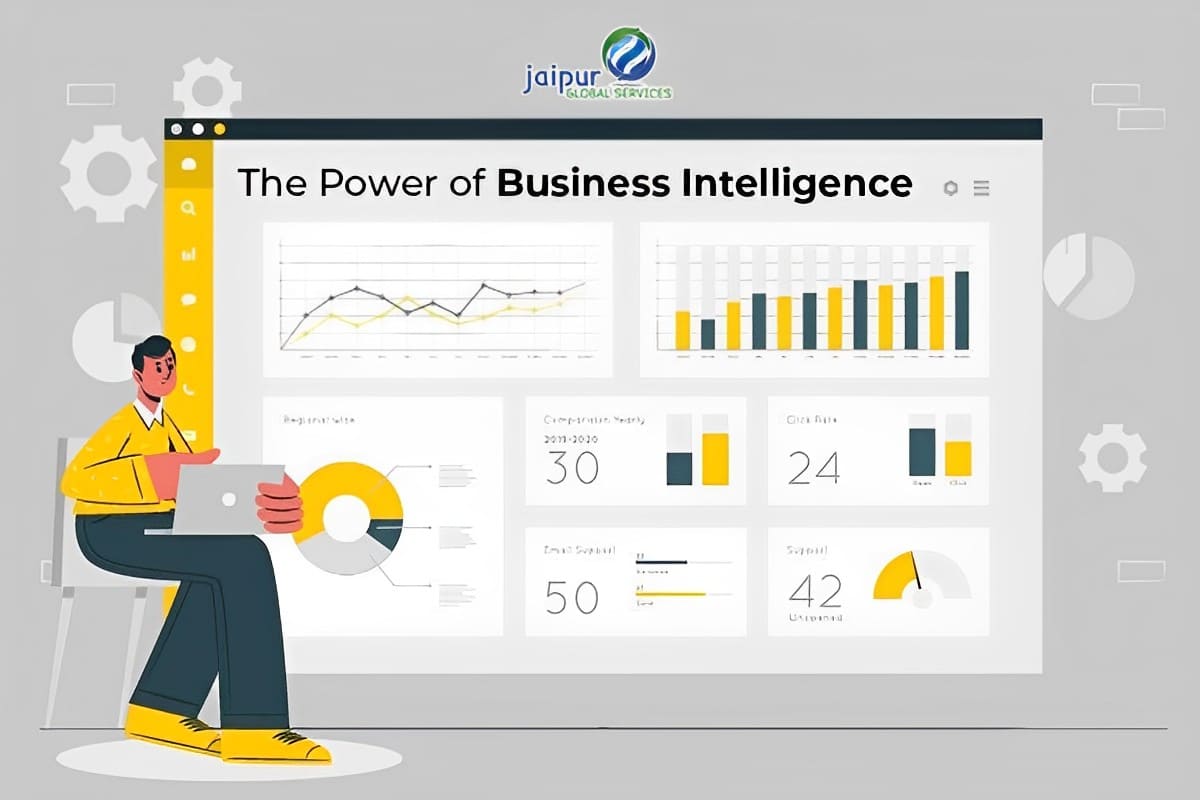
- jgservices
- May 16, 2023
- JGS
- 0 Comments
In today’s fast-paced and data-driven world, businesses are constantly seeking ways to gain a competitive edge. One such way is through the effective utilization of Business Intelligence (BI). This powerful tool empowers organizations to harness their data and extract valuable insights that can drive informed decision-making. In this article, we will delve into the power of Business Intelligence (BI) and explore how it can revolutionize the way businesses operate.
The Power of Business Intelligence (BI)
Business Intelligence (BI) is the process of gathering, analyzing, and transforming raw data into meaningful and actionable information. It provides organizations with a comprehensive view of their operations, customers, and market trends. The power of Business Intelligence lies in its ability to consolidate vast amounts of data from various sources and transform it into valuable insights.
With Business Intelligence, businesses can uncover hidden patterns, identify emerging trends, and make data-driven decisions. It enables organizations to optimize their operations, streamline processes, and identify new opportunities for growth. By leveraging the power of Business Intelligence, businesses can gain a competitive advantage in their industry and stay ahead of the curve.
The Benefits of Business Intelligence (BI)
Implementing a robust Business Intelligence strategy offers numerous benefits to organizations. Let’s explore some of the key advantages of harnessing the power of Business Intelligence:
1. Enhanced Decision-Making
Business Intelligence equips decision-makers with timely and accurate information, enabling them to make well-informed decisions. By consolidating data from various sources into intuitive dashboards and reports, BI tools provide a holistic view of the business, allowing decision-makers to analyze trends, patterns, and anomalies.

2. Improved Operational Efficiency
BI tools enable businesses to identify inefficiencies and bottlenecks within their operations. By analyzing data related to production, inventory, and supply chain, organizations can optimize processes, reduce costs, and improve overall efficiency. This empowers businesses to make data-driven decisions that drive operational excellence.

3. Enhanced Customer Understanding
Business Intelligence allows organizations to gain a deeper understanding of their customers. By analyzing customer data, such as purchase history, preferences, and behavior, businesses can personalize their marketing strategies, improve customer satisfaction, and drive customer loyalty. Understanding customer needs and preferences is vital for delivering exceptional customer experiences.

4. Competitive Advantage
In today’s competitive landscape, gaining a competitive edge is crucial for business success. Business Intelligence provides organizations with the tools to analyze market trends, monitor competitor activities, and identify new opportunities. By leveraging these insights, businesses can make proactive decisions and stay ahead of the competition.

5. Real-Time Insights
Traditional reporting methods often involve manual data extraction and analysis, leading to delays in accessing critical information. Business Intelligence tools provide real-time insights, enabling businesses to monitor key performance indicators (KPIs) and make informed decisions on the fly. Real-time data empowers organizations to respond swiftly to changing market conditions and make proactive adjustments.

Components of Business Intelligence
Business Intelligence (BI) comprises several components that work together to provide organizations with valuable insights and analytics. These components form the foundation of a robust BI system and enable businesses to make informed decisions based on data-driven insights. Let’s explore the key components of Business Intelligence:
1. Data Integration
Data integration involves collecting data from various sources, such as databases, spreadsheets, cloud applications, and external systems, and consolidating it into a unified view. This component ensures that data from different sources is combined and organized in a consistent and structured manner, enabling effective analysis.
2. Data Warehousing
Data warehousing involves storing large volumes of data in a central repository called a data warehouse. The data warehouse is specifically designed for efficient data retrieval and analysis. It provides a structured and optimized environment for storing historical and current data, making it easier to query and analyze.
3. Data Mining
Data mining is the process of extracting meaningful patterns and insights from large datasets. It involves using statistical algorithms, machine learning techniques, and pattern recognition to identify relationships, trends, and anomalies within the data. Data mining enables businesses to uncover hidden patterns and make predictions based on historical data.
4. Reporting and Querying
Reporting and querying components allow users to retrieve and present data in a structured format. Users can create custom reports, dashboards, and visualizations to analyze and communicate insights effectively. These components provide interactive and user-friendly interfaces for querying and exploring data, enabling users to gain insights quickly.
5. Analytics and Visualization
Analytics and visualization components enable businesses to analyze data and present it in a visual and interactive format. Advanced analytics techniques, such as statistical analysis, predictive modeling, and data forecasting, help uncover meaningful insights and trends. Visualization tools, such as charts, graphs, and maps, make it easier to understand complex data and communicate insights effectively.
6. Performance Management
Performance management components focus on monitoring key performance indicators (KPIs) and tracking business performance against predefined goals. These components provide real-time dashboards and scorecards that allow organizations to measure and track performance metrics. Performance management enables businesses to identify areas of improvement and make data-driven decisions to achieve organizational objectives.
7. Data Governance and Security
Data governance and security components ensure the integrity, privacy, and security of data within the BI system. They involve establishing policies, procedures, and controls to manage data quality, access, and usage. Data governance and security components are essential for maintaining data accuracy, compliance with regulations, and protecting sensitive information.
8. Collaboration and Knowledge Sharing
Collaboration and knowledge-sharing components facilitate sharing insights and promoting collaboration among users. These components enable users to collaborate on reports, share insights, and provide feedback. Collaboration features, such as commenting, annotation, and sharing functionalities, enhance teamwork and knowledge sharing within the organization.
9. Mobile BI
Mobile BI components allow users to access BI insights and reports on mobile devices, such as smartphones and tablets. Mobile BI provides on-the-go access to critical business information, enabling users to make informed decisions anytime, anywhere. These components offer responsive and user-friendly interfaces optimized for mobile devices.
10. Self-Service BI
Self-service BI components empower users to access and analyze data without relying on IT or technical expertise. These components provide intuitive interfaces and drag-and-drop functionalities, allowing users to create reports, visualize data, and perform ad-hoc analysis. Self-service BI promotes data exploration and empowers users to derive insights independently.
In conclusion, Business Intelligence (BI) is a powerful tool that enables businesses to harness their data and extract valuable insights. By consolidating and analyzing data from various sources, BI empowers organizations to make informed decisions, optimize operations, understand customers better, gain a competitive advantage, and access real-time insights. The key components of BI, such as data integration, warehousing, mining, reporting, analytics, and collaboration, work together to provide a comprehensive and user-friendly system for data-driven decision-making. With the power of BI, businesses can revolutionize the way they operate and stay ahead in today’s fast-paced, data-driven world.
